Whip up the perfect Caesar Salad with this homemade dressing! Packed with flavors of garlic, anchovy, lemon, and Parmesan, it’s creamy and utterly delicious. Ideal for sprucing up your salads, this easy-to-make dressing will become your new favorite.
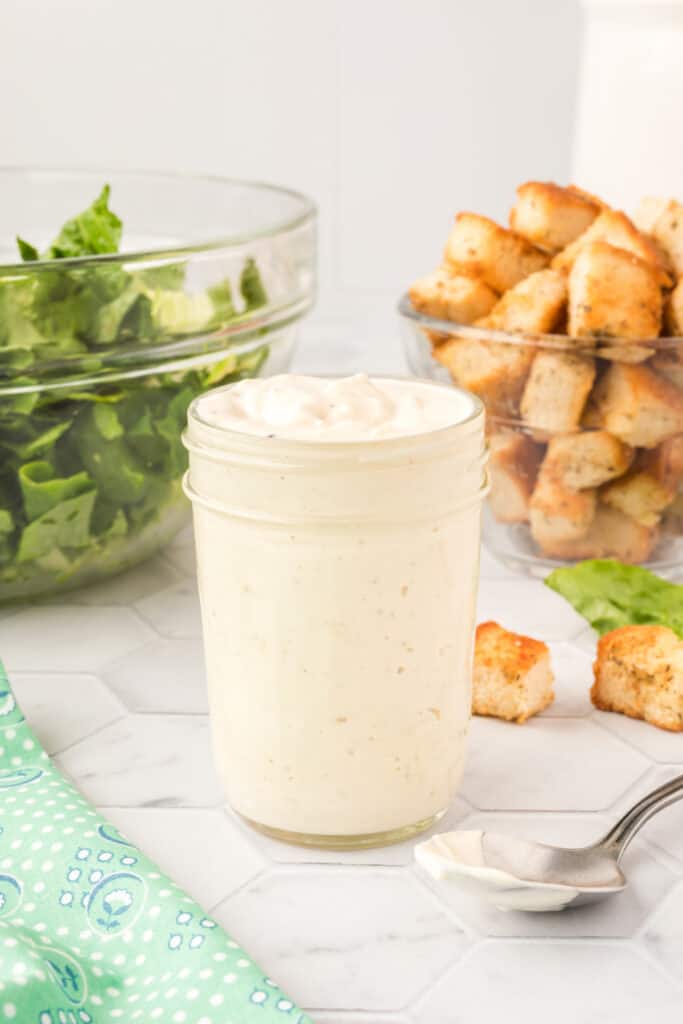
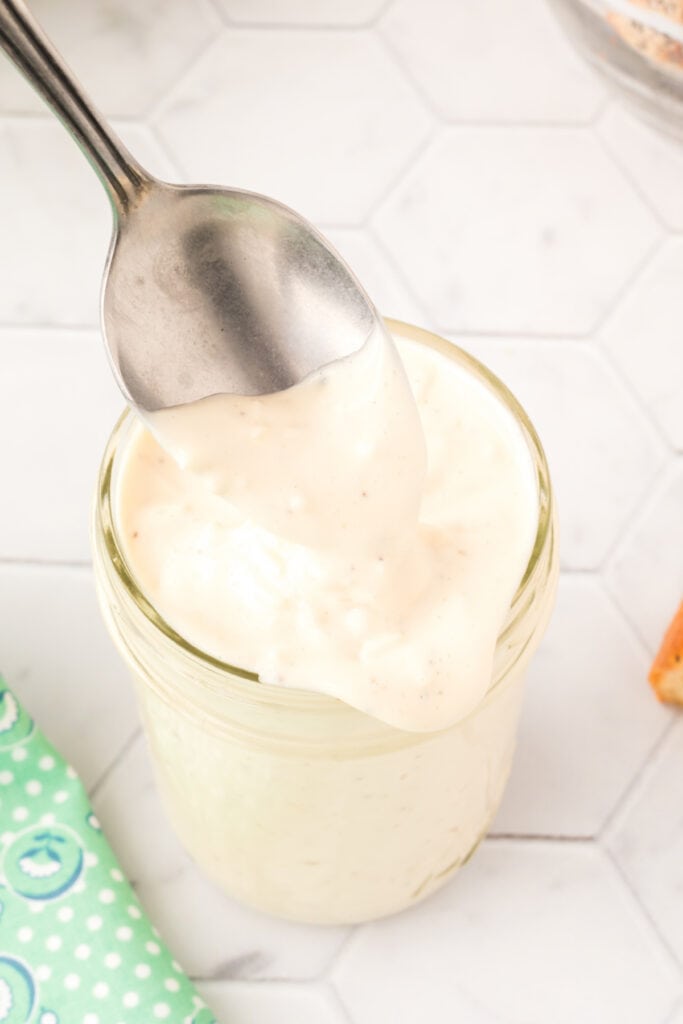
Caesar Dressing
Caesar Salad is a timeless classic that graces the tables of many, from cozy home dinners to upscale restaurants. At the heart of this beloved dish is the Caesar Dressing, a creamy, tangy concoction that brings life to the humble romaine lettuce. The magic of a good Caesar Salad Dressing recipe lies in its ability to balance flavors and textures, creating a harmony that elevates your salad experience.
When it comes to making Caesar Salad Dressing homemade, the journey is as rewarding as the destination. The process of blending the unique ingredients results in a dressing that’s far superior to any store-bought variant. A homemade Caesar Dressing is not just about the taste; it’s about the freshness and the absence of preservatives, ensuring a healthier option for your family.
Delving into the realm of Caesar Salad Dressing recipes, one discovers the diversity this dressing offers. Each ingredient in the recipe for Caesar salad dressing plays a pivotal role in crafting the final flavor profile. The robustness of garlic, the umami depth from anchovy, the zestiness of lemon, and the rich texture of Parmesan cheese come together in a symphony of flavors.
Making your own Caesar Salad Dressing homemade also offers the flexibility to adjust the ingredients to your liking. Whether you prefer a tangier lemon note or a subtler garlic presence, customizing your Caesar Dressing recipe allows you to create a version that perfectly suits your palate.
The allure of a homemade Caesar Salad Dressing recipe lies in its simplicity and the profound impact it has on transforming a simple salad into a gourmet delight. The next time you plan a salad, consider the difference a homemade Caesar Dressing can make. It’s not just a dressing; it’s an upgrade to your culinary experience.
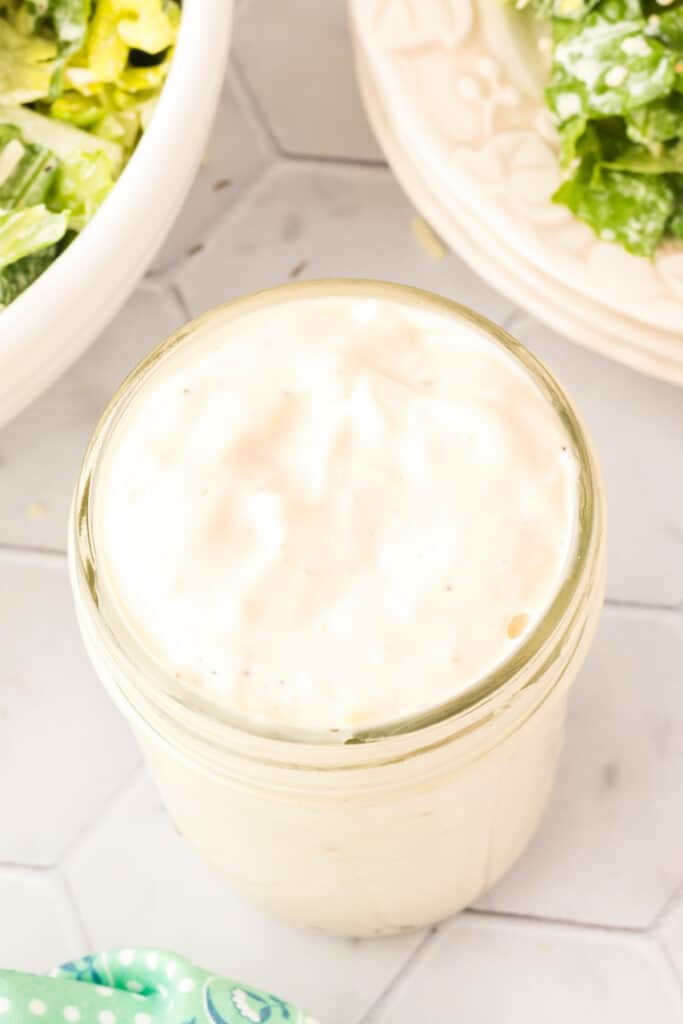
Origin of Caesar Salad Dressing
The origin of Caesar Salad Dressing is linked to the creation of Caesar Salad itself, which is an interesting tale of culinary improvisation. The salad and its distinctive dressing were created by an Italian restaurateur named Caesar Cardini in the early 20th century.
Cardini owned restaurants in Mexico and the United States. The most widely accepted story is that he invented the Caesar Salad at his restaurant in Tijuana, Mexico, around 1924. The legend goes that during a busy Fourth of July weekend, Cardini’s kitchen was running low on supplies. In a moment of inspiration, he threw together what ingredients he had left – romaine lettuce, garlic, croutons, Parmesan cheese, boiled eggs, olive oil, and Worcestershire sauce – to create a salad that would become a classic.
Cardini himself is credited with the original dressing recipe, which featured primarily olive oil, egg yolk, lemon juice, garlic, and Worcestershire sauce. Over time, anchovies were added to the recipe, although Cardini was said to have been opposed to their inclusion initially. His brother, Alex Cardini, later added anchovies to the dressing, and that version became more widely known as the traditional Caesar Dressing.
The popularity of the salad and its dressing grew rapidly, especially in the United States. Hollywood celebrities visiting Tijuana helped spread its fame. Today, Caesar Salad and its dressing are beloved worldwide, with countless variations existing.
Caesar Salad is an excellent example of how culinary creativity can lead to enduring and widespread food traditions. The dressing, in particular, with its creamy texture and bold flavors, has become a staple in many kitchens and restaurants.
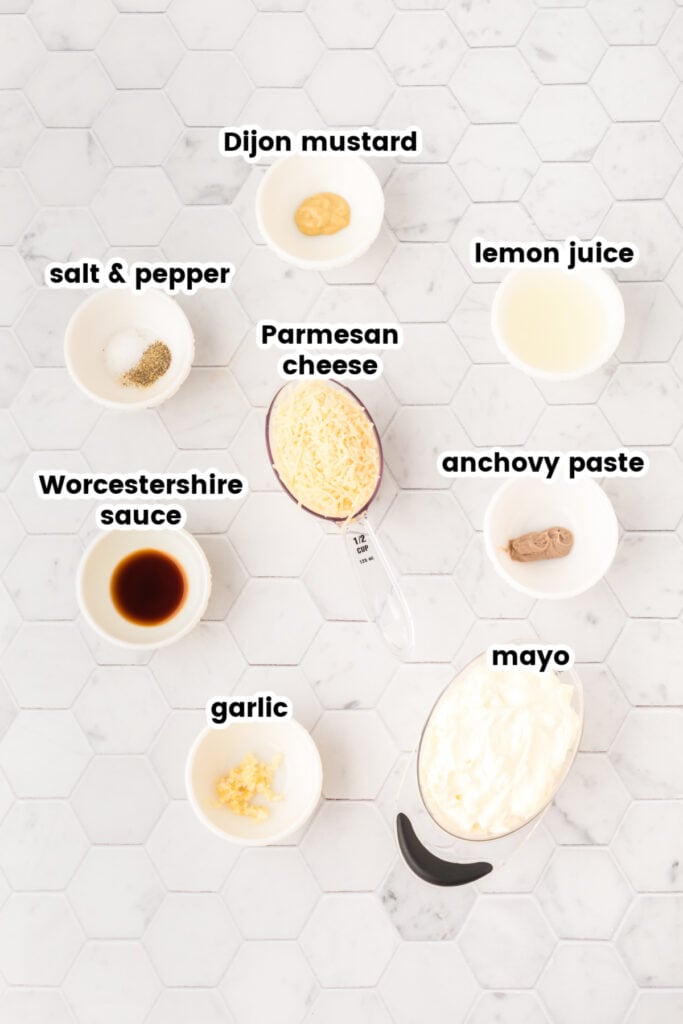
Caesar Dressing Recipe: Ingredients & Substitutions
To make this Caesar Salad Dressing recipe, you’ll need …
Would you like to save this?
Ingredients
- garlic cloves – If fresh garlic isn’t available, you can use 1/8 teaspoon of garlic powder as a substitute for each clove.
- anchovy paste – or mashed anchovy fillets. For a vegetarian option, capers can be a good substitute. They don’t mimic the exact flavor but offer a similar salty and briny taste. Use about 1 teaspoon of capers to replace 1 teaspoon of anchovy paste.
- freshly squeezed lemon juice – In a pinch, white wine vinegar or apple cider vinegar can replace lemon juice. They provide a similar acidic balance. Use them in equal proportions.
- Dijon mustard – If you’re out of Dijon, yellow mustard can work, but it’s milder and less complex in flavor. You might need to adjust the quantity to taste.
- Worcestershire sauce – Soy sauce or tamari can be used as a substitute. They don’t have the same flavor profile but do offer a similar depth of flavor.
- mayonnaise – For a healthier option, Greek yogurt or mashed avocado can be used. They change the flavor profile slightly but provide a creamy texture.
- freshly grated Parmesan cheese – For a dairy-free or vegan option, nutritional yeast can be a good substitute, offering a similar cheesy flavor. Alternatively, you can use another hard cheese like Grana Padano or Pecorino Romano.
- salt and freshly ground black pepper – These are basic seasonings, but you can adjust them to your taste or dietary needs.
Remember, substitutions can slightly alter the taste and texture of the dressing, so it might take some experimentation to get it just right for your preferences.
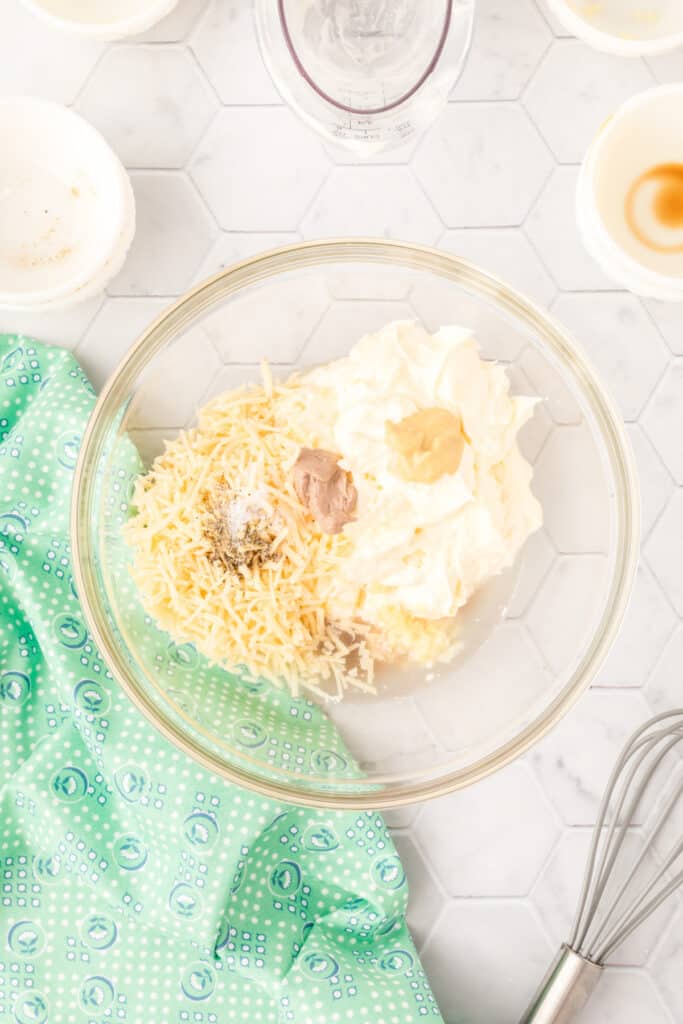
Serving Suggestions For Caesar Salad Dressing
Caesar Salad Dressing, with its creamy texture and robust flavor, is incredibly versatile and can elevate a variety of dishes. Here are some serving suggestions:
- Classic Caesar Salad: Toss it with romaine lettuce, croutons, and additional Parmesan cheese for a traditional Caesar salad.
- Chicken Caesar Wrap: Use the dressing as a spread in a wrap filled with grilled chicken, romaine lettuce, and Parmesan cheese.
- Vegetable Dip: It makes an excellent dip for fresh vegetables like carrots, celery, and bell peppers.
- Pasta Salad: Mix it into a cold pasta salad with ingredients like cherry tomatoes, olives, and grilled chicken for a flavorful meal.
- Marinade for Meats: The dressing can be used as a marinade for chicken or steak, adding a flavorful zest to grilled meats.
- Sandwich Spread: Use it instead of mayonnaise on sandwiches and burgers for an extra kick of flavor.
- Seafood Salad: Drizzle it over a seafood salad featuring shrimp, crab, or lobster.
- Roasted Vegetables: Toss it with vegetables like broccoli, Brussels sprouts, or asparagus before roasting for a delicious side dish.
- Potato Salad: Give your potato salad a twist by using Caesar dressing instead of the traditional mayonnaise-based dressing.
- Pizza Topping: Use it as a base sauce for a unique pizza, topped with chicken, cheese, and vegetables.
These are just a few ideas to get you started. Caesar Salad Dressing is a dynamic ingredient that can be used in many creative ways to enhance your meals.
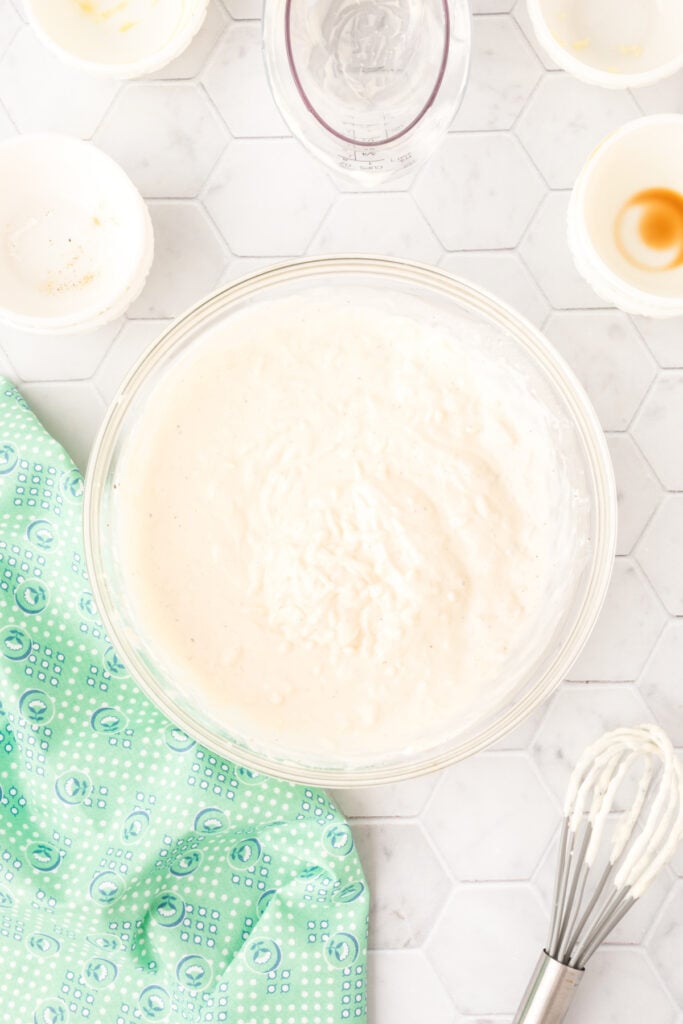
Caesar Salad Dressing: FAQs
It typically includes garlic, anchovy paste, lemon juice, Dijon mustard, Worcestershire sauce, mayonnaise, Parmesan cheese, salt, and black pepper.
Yes, you can substitute anchovies with capers for a similar salty flavor or simply omit them for a vegetarian version.
Traditional Caesar Dressing can be gluten-free, but it depends on the ingredients used, especially in Worcestershire sauce and mayonnaise. Always check labels if you’re sensitive to gluten.
When stored in a sealed container in the refrigerator, homemade Caesar Dressing typically lasts for up to one week.
Yes, you can use vegan mayonnaise, omit the anchovies, and use a plant-based Parmesan cheese alternative.
Fresh lemon juice is preferred for flavor, but bottled lemon juice can be used in a pinch.
If your dressing is too thin, you can add more mayonnaise or Parmesan cheese to thicken it.
While flavorful, it is high in calories and fat due to mayonnaise and cheese. For a healthier version, use low-fat mayonnaise or substitute part of it with Greek yogurt.
Freezing is not recommended as it can affect the texture and emulsion of the dressing.
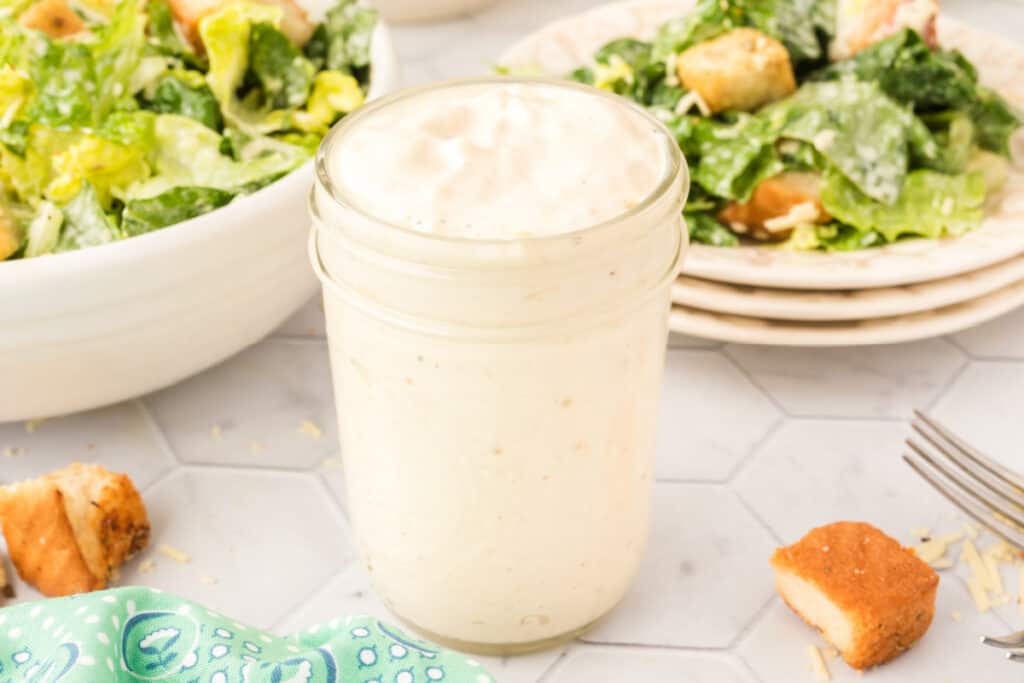
Other recipes you may enjoy
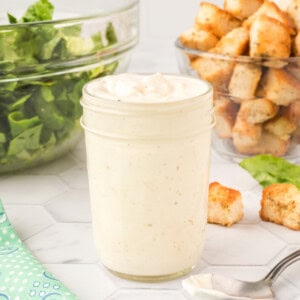
Caesar Salad Dressing
Equipment
Ingredients
- 2 cloves garlic minced
- 1 teaspoon anchovy paste
- 2 tablespoons freshly squeezed lemon juice
- 1 teaspoon Dijon mustard
- 1 teaspoon Worcestershire sauce
- 1 cup mayonnaise
- ½ cup freshly grated Parmesan cheese
- ¼ teaspoon salt
- ¼ teaspoon freshly ground black pepper
Instructions
- In a small bowl, combine all ingredients with a wire whisk until well combined.
- Serve immediately.
Notes
- This dressing keeps well in a covered container in the refrigerator for up to one week.
- DON’T skip the anchovy paste – it really adds a crucial flavor.
Nutrition
Please note that the nutritional information listed on this page is an estimation based on the products I used. Ingredients and nutritional information can vary significantly between brands. Always be sure to read labels. Please verify that a recipe fits your needs before using it. Nutrition info may contain errors, so please verify it independently. Likewise, recipes may contain errors, so please use your common sense when following them.


Delicious!